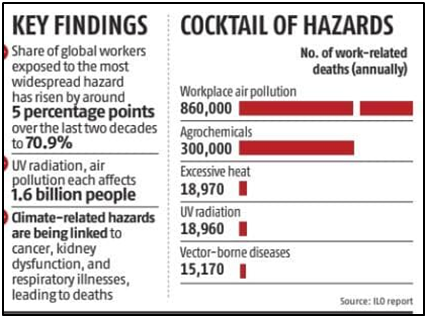Why in the News?
The International Labour Organisation (ILO) has published a report title "Ensuring safety and health at work in a changing climate".
What’s in Today’s Article?
- About ILO (Background, Objectives, Members, etc.)
- About ILO’s Report (Key Highlights of the Report)
About International Labour Organisation:
- The ILO was created in 1919, as part of the Treaty of Versailles that ended World War I, to reflect the belief that universal and lasting peace can be accomplished only if it’s based on social justice.
- In 1946, the ILO became a specialized agency of the United Nations.
- The ILO is devoted to promoting social justice and internationally recognized human and labour rights, pursuing its founding mission that labour peace is essential to prosperity.
- Headquarters: Geneva, Switzerland
Objectives of ILO:
- The ILO has four strategic objectives:
- Promote and realize standards and fundamental principles and rights at work,
- Create greater opportunities for women and men to decent employment and income,
- Enhance the coverage and effectiveness of social protection for all, and
- Strengthen tripartism and social dialogue.
Membership of ILO:
- The ILO has 187 state members.
- India is a founding member of the ILO and it has been a permanent member of the ILO Governing Body since 1922.
- The ILO constitution permits any member of the UN to become a member of the ILO.
- To gain membership, a nation must inform the director-general that it accepts all the obligations of the ILO constitution.
Ensuring Safety and Health at Work in a Changing Climate Report:
- The ILO published this report to bring attention to the global health threat workers are currently facing.
- A scoping exercise was conducted to identify the most recent trends and priorities for climate change and worker safety and health.
- Based on the available evidence, the report addresses the following key issues:
- Excessive heat
- Ultraviolet (UV) radiation
- Extreme weather events
- Workplace air pollution
- Vector-borne diseases
- Agrochemicals
- Key Highlights of the Report:

- Billions of workers are exposed to hazards exacerbated by climate change.
- Workers across different sectors are exposed to these hazards but some workers, such as agricultural workers and other outdoor workers carrying out heavy labour in hot climates are particularly at risk.
- Strong evidence demonstrates that numerous health conditions in workers have been linked to climate change, including cancer, cardiovascular disease, respiratory illnesses, kidney dysfunction and mental health conditions, among many others.
- Every year, an estimated 22.85 million occupational injuries, 18,970 deaths and 2.09 million disability-adjusted life years (DALYs) are attributable to excessive heat alone.
- Thousands more die from pesticide poisoning (>300,000), workplace air pollution (>860,000), solar UV radiation (>18,960 due to non-melanoma skin cancer alone) and parasitic and vector-borne diseases.










